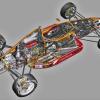Interesting thread - not least the Gardner article

What strikes me as odd when viewing the cutaway is this: Where are the front springs and dampers? And where do the aft inboard pick-up points for the lower front wishbones go? For the former I assume they were to have been outboard, judging by the upper and lower wishbone designs, and maybe there was to have been a tubular framework in the style of both 001/003 and 007 to pick up a forward facing lower wishbone leg, instead of the one running aft as shown in Brian Hatton's cutaway - it looks like Hatton didn't have all the actual design data available for his sketch.
Still, it was a neat shape - I always fancied Gordon Murray's trapezoidal section Brabham chassis, although, IIRC, Geoff Ferris had set that precedent at Brabham, and the shape also seems to have inspired John Sutrees/Ken Sears on the TS19-20 as well as Andy Smallman's Hill GH2. Gardner mentions himself in the article here that he was inspired by Phillippe's intrigueing 1972 Indy Parnelli, which had both dihedral front fins, in addition to conventional horizontal nose fins, acting as fairings for the front upper 'wishbone' inboard pivots, complete with adjustable trailing edge flaps, and the trapezoidal chassis cross section with flush NACA radiator inlets...there was a lot of experiementation and variety in those days...
From reading about Garnder's lift problems, I wonder how it was overcome on other large plan area, flat-bottom designs, particularly of the trapezoidal section variety? Len Terry sort of turned the shape 'upside down' when he replaced the trapezoidal/wedge1969 Indy Eagle with his 1970 Eagle design, yet others persevered succesfully with it. Perhaps the trick was to taper the shape in plan view, tapering towards a narrow front?
I also find it intrigueing that the 006 could end up more than 100 lbs overweight, and still remain competitive. How an experienced designer as Gardner failed to manage weight to the point that they were almost one third out (of the 'variable' 350 lbs stated by Gardner) puzzles me, but in fairness I suppose the rim widths and tyre sizes, as well as tyre weights, grew significantly in the life of 005/006, and the final wording of the deformable structure/ chassis outer skin gauge rules caught Gardner on the wrong foot. Still, as he said, the 006 was highly competitive, the 72 and M23 probably having their own weight challenges. Or perhaps Gardner was sandbagging (pun intended) somewhat on the 110 lbs surplus weight issue?
I also agree with Gardner that 006 ended up an aesthetic mess - bu a fast mess! The original 005 was, to me, although rather 'stubby', one of the most well-proportioned, cleanest, neatest and most homegenous appearing F1 cars of the period. Unlike many cars of the period, 005 appeared to have been designed (and that by one man), witness the level of aerodynamic integration of chassis, oil cooler inlets, cockpit coaming, engine cover and airbox, rather than somewhat 'cobbled together' like a lot of its contemporaries; the proportions went on the Tyrrel when the airbox went up and the rear wing went aft.































